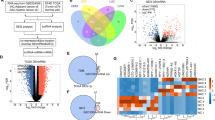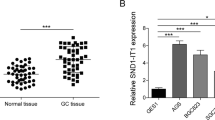Abstract
Gastric cancer (GC) is a heterogeneous disease at the molecular and clinical levels. The diffuse subtype is associated with more aggressive behavior and poor prognosis than the intestinal subtype. Epithelial-to-mesenchymal transition (EMT) may be involved in the diffuse mesenchymal phenotype. Long non-coding RNA (lncRNA) deregulation plays a vital role in GC development and progression. Here, we aimed to comprehensively disclose lncRNAs associated with GC diffuse/mesenchymal type. RNA-sequencing expression profiles of patients with stomach adenocarcinoma and the corresponding clinical data were downloaded from The Cancer Genome Atlas database. Differentially expressed lncRNAs related to tumor samples and diffuse subtype were identified. The lncRNA activating regulator of DKK1 (LNCAROD) was experimentally studied. Furthermore, a lncRNA-miRNA-mRNA network was constructed to identify potential biological functions of LNCAROD. LNCAROD expression was detected by reverse transcription-quantitative polymerase chain reaction in GC cell lines. LNCAROD expression was silenced using the small interference RNA strategy. Cell proliferation and migration were evaluated using colony formation assay, scratch wound healing, and Transwell migration assays. LNCAROD was significantly upregulated in some GC cells. The knocking down of LNCAROD significantly reduced cell proliferation and migration. LNCAROD-miR-181-PROX1 axis was introduced as a potential regulatory mechanism by which LNCAROD may exert its functions in cells. Our findings highlight that LNCAROD is involved in cell proliferation and migration in GC and supports its implicit role in regulating EMT. It may serve as a potential diagnostic and therapeutic target in GC. In addition, LNCAROD may function through the possible regulatory axis in GC development.





Similar content being viewed by others
Data availability
Data will be available in online resource tables submitted as Supplementary Materials.
References
Arun G, Diermeier SD, Spector DL (2018) Therapeutic targeting of long non-coding RNAs in cancer. Trends Mol Med 24:257–277. https://doi.org/10.1016/j.molmed.2018.01.001
Ban Y, Tan P, Cai J, Li J, Hu M, Zhou Y, Mei Y, Tan Y, Li X, Zeng Z, Xiong W, Li G, Li X, Yi M, Xiang B (2020) LNCAROD is stabilized by m6A methylation and promotes cancer progression via forming a ternary complex with HSPA1A and YBX1 in head and neck squamous cell carcinoma. Mol Oncol 14:1282–1296. https://doi.org/10.1002/1878-0261.12676
Bass AJ, Thorsson V, Shmulevich I, Reynolds SM, Miller M, Bernard B, Hinoue T, Laird PW, Curtis C, Shen H, Weisenberger DJ, Schultz N, Shen R, Weinhold N, Kelsen DP, Bowlby R, Chu A, Kasaian K, Mungall AJ, … Liu J (2014) Comprehensive molecular characterization of gastric adenocarcinoma. Nature 513: 202–209. https://doi.org/10.1038/nature13480
Bourne R (2010) ImageJ Fundam Digit Imaging Med 9:185–188. https://doi.org/10.1007/978-1-84882-087-6_9
Chen G, Shen Z-L, Wang L, Lv C-Y, Huang X-E, Zhou R-P (2013) Hsa-miR-181a-5p expression and effects on cell proliferation in gastric cancer. Asian Pac J Cancer Prev 14:3871–3875. https://doi.org/10.7314/apjcp.2013.14.6.3871
Chen Q, Hu C, Sun K, Lang Y (2019) LncRNA NR027113 promotes malignant progression of gastric carcinoma via EMT signaling pathway. Eur Rev Med Pharmacol Sci 23:4746–4755
Colaprico A, Silva TC, Olsen C, Garofano L, Cava C, Garolini D, Sabedot TS, Malta TM, Pagnotta SM, Castiglioni I, Ceccarelli M, Bontempi G, Noushmehr H (2016) TCGAbiolinks: an R/Bioconductor package for integrative analysis of TCGA data. Nucleic Acids Res 44:e71. https://doi.org/10.1093/nar/gkv1507
Cristescu R, Lee J, Nebozhyn M, Kim KM, Ting JC, Wong SS, Liu J, Yue YG, Wang J, Yu K, Ye XS, Do IG, Liu S, Gong L, Fu J, Jin JG, Choi MG, Sohn TS, Lee JH, … Aggarwal A (2015) Molecular analysis of gastric cancer identifies subtypes associated with distinct clinical outcomes. Nat Med 21:449–456.https://doi.org/10.1038/nm.3850
Cutsem EV, Sagaert X, Topal B, Haustermans K, Prenen H (2016) Gastric cancer. Lancet 388:2654–2664. https://doi.org/10.1016/S0140-6736(16)30354-3
Dongre A, Weinberg RA (2019) New insights into the mechanisms of epithelial–mesenchymal transition and implications for cancer. Nat Rev Mol Cell Biol 20:69–84. https://doi.org/10.1038/s41580-018-0080-4
Etemadi A, Safiri S, Sepanlou SG, Ikuta K, Bisignano C, Shakeri R, Amani M, Fitzmaurice C, Nixon MR, Abbasi N, Abolhassani H, Advani SM, Afarideh M, Akinyemiju T, Alam T, Alikhani M, Alipour V, Allen CA, Almasi-Hashiani A, … Sajadi P (2020) The global, regional, and national burden of stomach cancer in 195 countries, 1990–2017: a systematic analysis for the Global Burden of Disease study 2017. Lancet Gastroenterol. Hepatol 5:42–54. https://doi.org/10.1016/S2468-1253(19)30328-0
Fukunaga T, Iwakiri J, Ono Y, Hamada M (2019) Lncrrisearch: a web server for lncRNA-RNA interaction prediction integrated with tissue-specific expression and subcellular localization data. Front Genet 10:1–6. https://doi.org/10.3389/fgene.2019.00462
Gao W, Chan JY-W, Wong T-S (2014) Long non-coding RNA deregulation in tongue squamous cell carcinoma. Biomed Res Int 2014:405860. https://doi.org/10.1155/2014/405860
Gugnoni M, Ciarrocchi A (2019) Long noncoding RNA and epithelial mesenchymal transition in cancer. Int J Mol Sci 20:1–25. https://doi.org/10.3390/ijms20081924
Gullo I, Carneiro F, Oliveira C, Almeida GM (2018) Heterogeneity in gastric cancer: from pure morphology to molecular classifications. Pathobiology 85:50–63
Hamashima C, Kato K, Miyashiro I, Nishida H, Takaku R, Terasawa T, Yoshikawa T, Honjo S, Inoue K, Nakayama T, Nakayama T, Narisawa R, Sagawa M, Saito H, Shibuya D, Sobue T (2018) Update version of the Japanese guidelines for gastric cancer screening. Jpn J Clin Oncol 48:673–683. https://doi.org/10.1093/jjco/hyy077
Jia G, Wang Y, Lin C, Lai S, Dai H, Wang Z, Dai L, Su H, Song Y, Zhang N, Feng Y, Tang B (2021) LNCAROD enhances hepatocellular carcinoma malignancy by activating glycolysis through induction of pyruvate kinase isoform PKM2. J Exp Clin Cancer Res 40:1–18. https://doi.org/10.1186/s13046-021-02090-7
Jiménez Fonseca P, Carmona-Bayonas A, Hernández R, Custodio A, Cano JM, Lacalle A, Echavarria I, Macias I, Mangas M, Visa L, Buxo E, Álvarez Manceñido F, Viudez A, Pericay C, Azkarate A, Ramchandani A, López C, Martinez de Castro E, Fernández Montes A, … Gallego J (2017) Lauren subtypes of advanced gastric cancer influence survival and response to chemotherapy: real-world data from the AGAMENON National Cancer Registry. Br J Cancer 117: 775–782. https://doi.org/10.1038/bjc.2017.245
Kern F, Aparicio-Puerta E, Li Y, Fehlmann T, Kehl T, Wagner V, Ray K, Ludwig N, Lenhof H-P, Meese E, Keller A (2021) miRTargetLink 2.0-interactive miRNA target gene and target pathway networks. Nucleic Acids Res 49:409–416. https://doi.org/10.1093/nar/gkab297
Laitinen A, Böckelman C, Hagström J, Kokkola A, Kallio P, Haglund C (2017) High PROX1 expression in gastric cancer predicts better survival. PLoS ONE 12:e0183868. https://doi.org/10.1371/journal.pone.0183868
Lauren P (1965) The two histological main types of gastric carcinoma: diffuse and so-called intestinal-type carcinoma. An attempt at a histo-clinical classification. Acta Pathol Microbiol Scand 64:31–49. https://doi.org/10.1111/apm.1965.64.1.31
Liao Y, Wang J, Jaehnig EJ, Shi Z, Zhang B (2019) WebGestalt 2019: gene set analysis toolkit with revamped UIs and APIs. Nucleic Acids Res 47:W199–W205. https://doi.org/10.1093/nar/gkz401
Liu Z-QQ, He W-FF, Wu Y-JJ, Zhao S-LL, Wang L, Ouyang Y-YY, Tang S-YY (2020) LncRNA SNHG1 promotes EMT process in gastric cancer cells through regulation of the miR-15b/DCLK1/Notch1 axis. BMC Gastroenterol 20:156. https://doi.org/10.1186/s12876-020-01272-5
Livak KJ, Schmittgen TD (2001) Analysis of relative gene expression data using real-time quantitative PCR and the 2-ΔΔCT method. Methods 25:402–408. https://doi.org/10.1006/meth.2001.1262
Ma J, Shen H, Kapesa L, Zeng S (2016) Lauren classification and individualized chemotherapyin gastric cancer (Review). Oncol Lett 11:2959–2964. https://doi.org/10.3892/ol.2016.4337
Mokadem I, Dijksterhuis WPM, van Putten M, Heuthorst L, de Vos-Geelen JM, Haj Mohammad N, Nieuwenhuijzen GAP, van Laarhoven HWM, Verhoeven RHA (2019) Recurrence after preoperative chemotherapy and surgery for gastric adenocarcinoma: a multicenter study. Gastric Cancer 22:1263–1273. https://doi.org/10.1007/s10120-019-00956-6
National Cancer Institute (2019) Gastric Cancer Treatment (PDQ®): Health Professional Version. Gastric Cancer Treatment (PDQ). http://www.ncbi.nlm.nih.gov/pubmed/26389209. Accessed 22 Feb 2022
Ntini E, Louloupi A, Liz J, Muino JM, Marsico A, Ørom U AV (2018) Long ncRNA A-ROD activates its target gene DKK1 at its release from chromatin. Nat Commun 9. https://doi.org/10.1038/s41467-018-04100-3
Oh S, Sohn C, Bo H, Cheong J-H, Kim S-B, Lee JE (2018) Clinical and genomic landscape of gastric cancer with a mesenchymal phenotype. Nat Commun 9:1–14
Sung H, Ferlay J, Siegel RL, Laversanne M, Soerjomataram I, Jemal A, Bray F (2021) Global Cancer Statistics 2020: GLOBOCAN estimates of incidence and mortality worldwide for 36 cancers in 185 countries. CA Cancer J Clin 71:209–249. https://doi.org/10.3322/caac.21660
Tan TZ, Miow QH, Miki Y, Noda T, Mori S, Huang RY-J, Thiery JP (2014) Epithelial-mesenchymal transition spectrum quantification and its efficacy in deciphering survival and drug responses of cancer patients. EMBO Mol Med 6:1279–1293. https://doi.org/10.15252/emmm.201404208
Ueta K, Otowa Y, Kakeji Y, Hirashima M (2018) PROX1 is associated with cancer progression and prognosis in gastric cancer. Anticancer Res 38:6139–6145. https://doi.org/10.21873/anticanres.12966
Ye B, Li F, Chen M, Weng Y, Qi C, Xie Y, Zhang Q, Ding H, Zhang J, Gao X (2022) A panel of platelet-associated circulating long non-coding RNAs as potential biomarkers for colorectal cancer. Genomics 114:31–37. https://doi.org/10.1016/j.ygeno.2021.11.026
Yuan L, Li J, Yi Y, Chen Y, Bu Y, Ye M, Mao X, Ma T, Yu L, Nan Y (2021) LINC00514 promotes gastric cancer cell growth and EMT progression. Aging (Albany. NY) 13:12007–12015
Yuan Y, Zhou D, Chen F, Yang Z, Gu W, Zhang K (2022) SIX5-activated LINC01468 promotes lung adenocarcinoma progression by recruiting SERBP1 to regulate SERPINE1 mRNA stability and recruiting USP5 to facilitate PAI1 protein deubiquitylation. Cell Death Dis 13:1–13. https://doi.org/10.1038/s41419-022-04717-9
Acknowledgements
The authors would like to thank Isfahan University of Medical Sciences and the Iran National Science Foundation (INSF) for funding this work through grant numbers 397114 and 96013247, respectively. The data and results shown here are partly based upon data generated by the TCGA Research Network: https://www.cancer.gov/tcga.
Funding
The authors disclosed receipt of the following financial support for the research: This work was supported by the Isfahan University of Medical Sciences (grant number 397114), and the Iran National Science Foundation (INSF) (grant number 96013247).
Author information
Authors and Affiliations
Contributions
All authors participated in the design, interpretation of the studies, analysis of the data, and review of the manuscript; Sara Ansari and Parvaneh Nikpour conceived and designed the research, Sara Ansari collected the data and conducted the experiments, Sara Ansari and Parvaneh Nikpour performed the analysis, and Sara Ansari and Parvaneh Nikpour wrote the manuscript.
Corresponding author
Ethics declarations
Ethics approval
This study was performed in line with the principles of the Declaration of Helsinki. Approval was granted by the Ethics Committee of Isfahan University of Medical Sciences, Isfahan, Iran (Date 02/09/2018. /No: IR.MUI.RESEAECH.REC.1397.116).
Competing interests
The authors declare no competing interests.
Additional information
Publisher's note
Springer Nature remains neutral with regard to jurisdictional claims in published maps and institutional affiliations.
Supplementary Information
Below is the link to the electronic supplementary material.
Rights and permissions
Springer Nature or its licensor (e.g. a society or other partner) holds exclusive rights to this article under a publishing agreement with the author(s) or other rightsholder(s); author self-archiving of the accepted manuscript version of this article is solely governed by the terms of such publishing agreement and applicable law.
About this article
Cite this article
Ansari, S., Nikpour, P. LNCAROD promotes the proliferation and migration of gastric cancer: a bioinformatics analysis and experimental validation. Funct Integr Genomics 23, 34 (2023). https://doi.org/10.1007/s10142-022-00954-5
Received:
Revised:
Accepted:
Published:
DOI: https://doi.org/10.1007/s10142-022-00954-5




